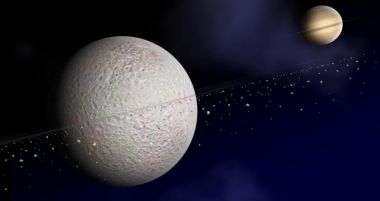Saturn's Moon Rhea Sports a Dusty Halo

Who'd have guessed that Saturn has its own moon-sized vacuum cleaners, circling the ringed planet and sucking up electrons from the plasma at the orbit of the icy moons. Or that one of Saturn's moons has its very own vacuum in the form of a hitherto-unknown dust halo, not quite visible as a ring, around the midsection of Rhea, discovered by NASA's Cassini spacecraft. Cassini is carrying among its instruments a pair of ion-mass and ion-beam spectrometers built by Los Alamos National Laboratory.
News of Rhea's hidden ring and its plasma-depleting capabilities is appearing in a Science magazine paper March 7, 2008, "The Dust Halo of Saturn's Largest Icy Moon, Rhea," which lists among its 35 coauthors Los Alamos space scientists Hazel J. McAndrews, Robert Tokar and Robert J. Wilson.
"Los Alamos is in a unique position to have this expertise in building space instrumentation," said McAndrews, a recent import to the Laboratory from the Mullard Space Science Laboratory at University College, London.
"Indeed, the Lab's expertise in understanding Earth's magnetosphere makes it particularly well suited to this type of research--as scientists like to say, 'the same physics apply on Earth as on Saturn, but it's just a different laboratory'," said Wilson.
The Cassini Plasma Spectrometer (CAPS) consists of three separate analyzers designed to measure the electrically charged particles trapped within Saturn's magnetosphere. Los Alamos played a major role in the design and construction of two of them: an ion mass spectrometer (IMS), which incorporates a novel design developed at Los Alamos to identify the different atomic species in Saturn's magnetospheric plasma; and an ion beam spectrometer (IBS), which is based on a design used by Los Alamos scientists on several previous solar wind research missions.
Key insights into the ion data have come from Los Alamos teammate Wilson, a doctoral graduate of the Imperial College of Science, Technology and Medicine, London. Wilson, having focused on planetary magnetospheric studies, is examining Saturn's magnetosphere, particularly the plasma properties, densities, pressure, and speed of rotation--all data that will aid understanding of the global Saturnian system and aid the many researchers creating computer simulations of the ringed planet by providing known values.
"This moon carves a hole in the plasma," Wilson noted, and even though the spacecraft does not rotate to give the instruments a view of all possible directions, he and other experts in the field have put their expertise to the test in understanding what their data can tell them about this unique feature of the icy moon.
Source: Los Alamos National Laboratory





















